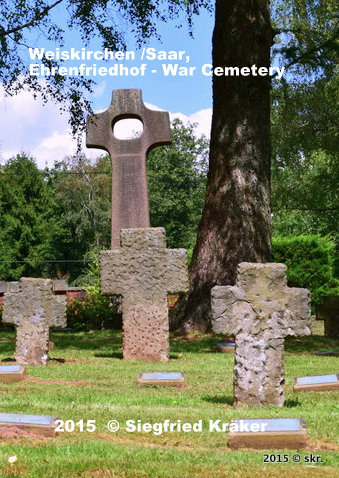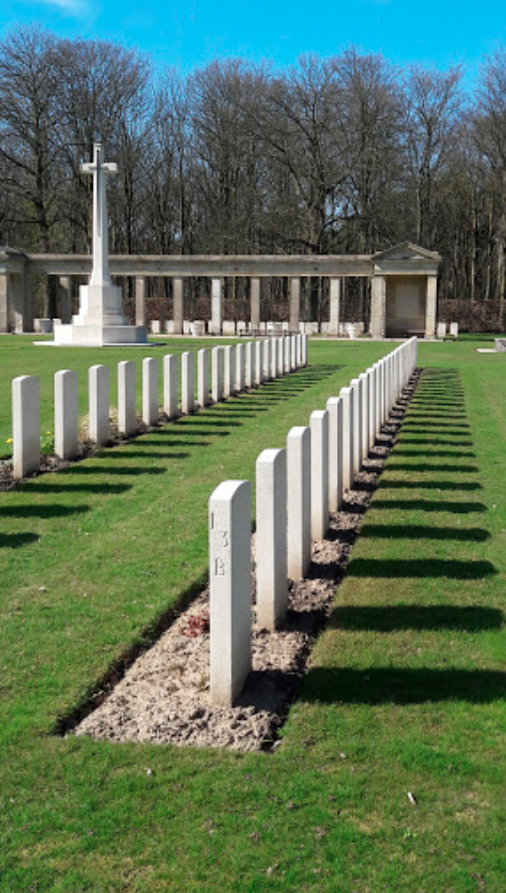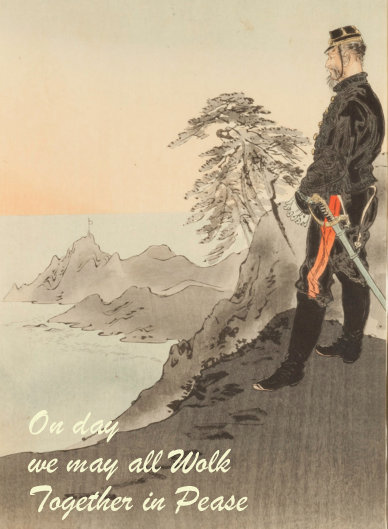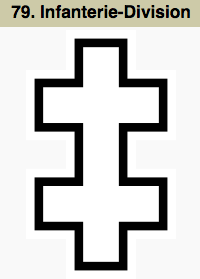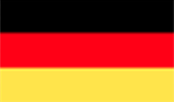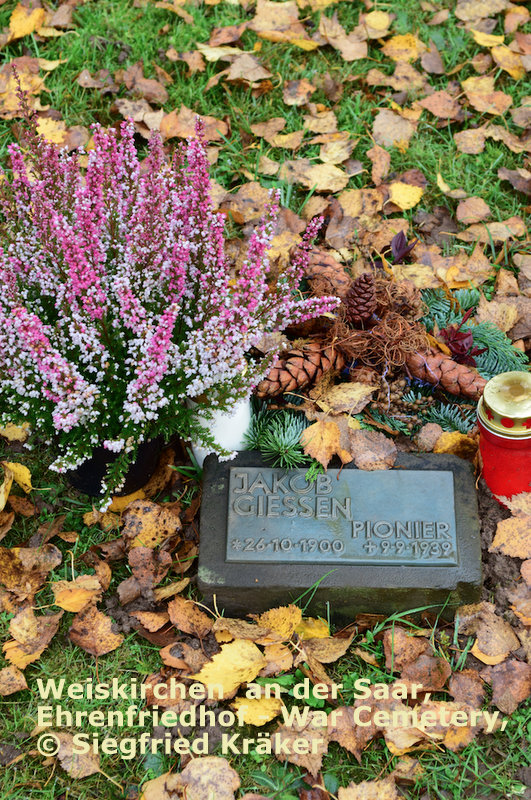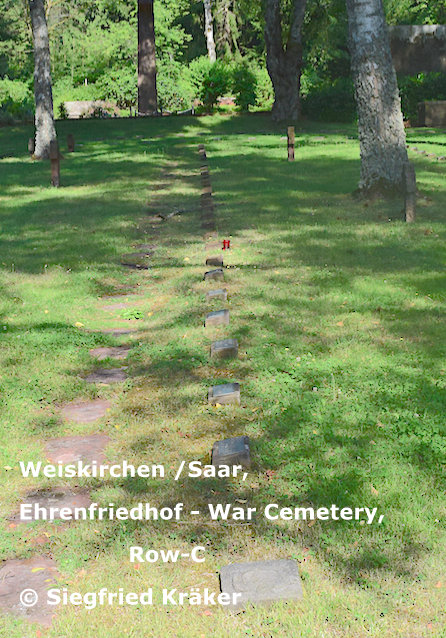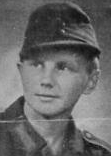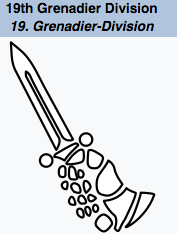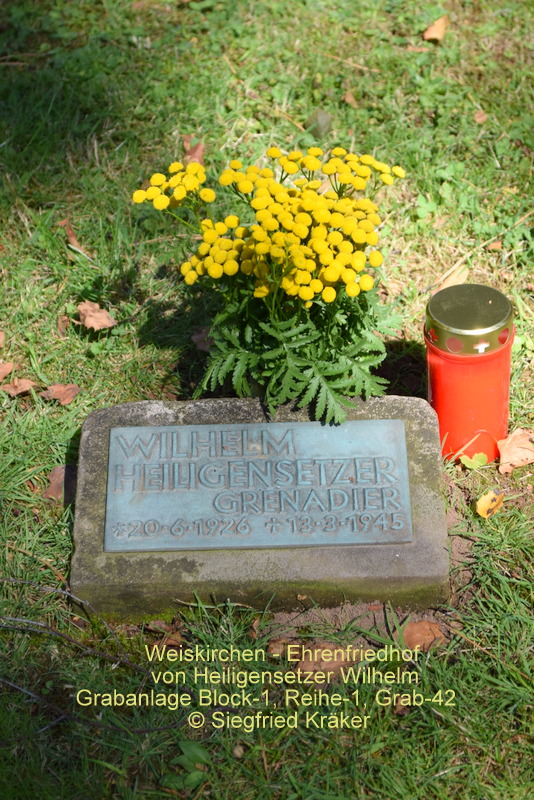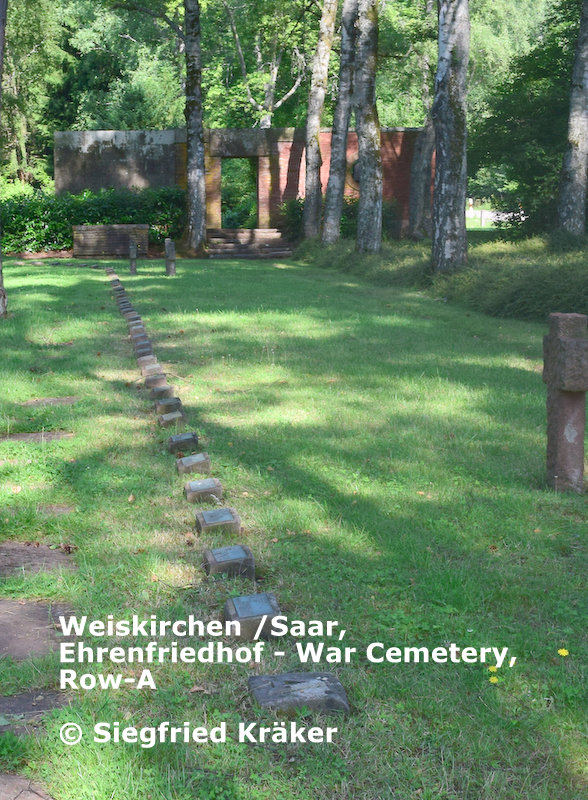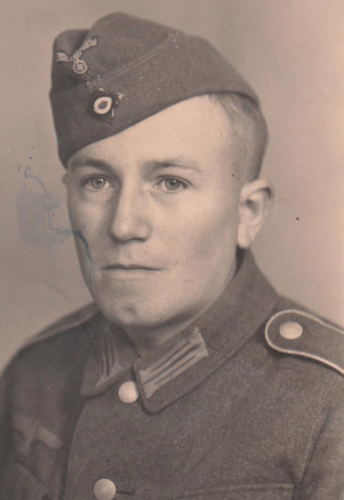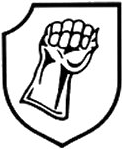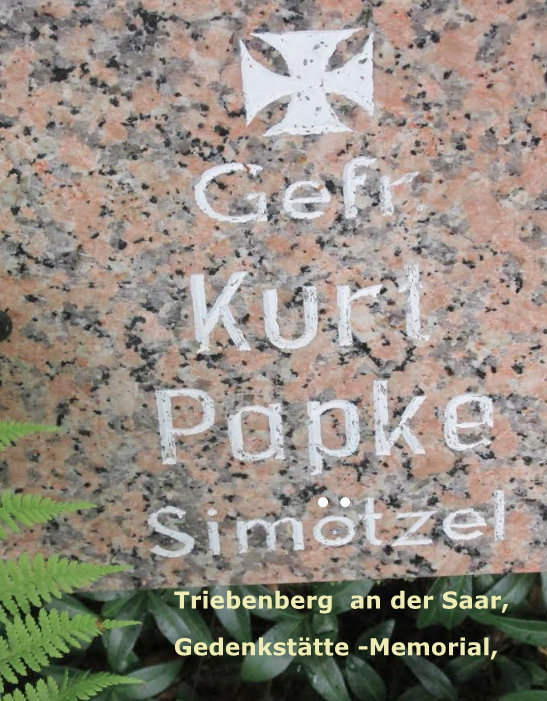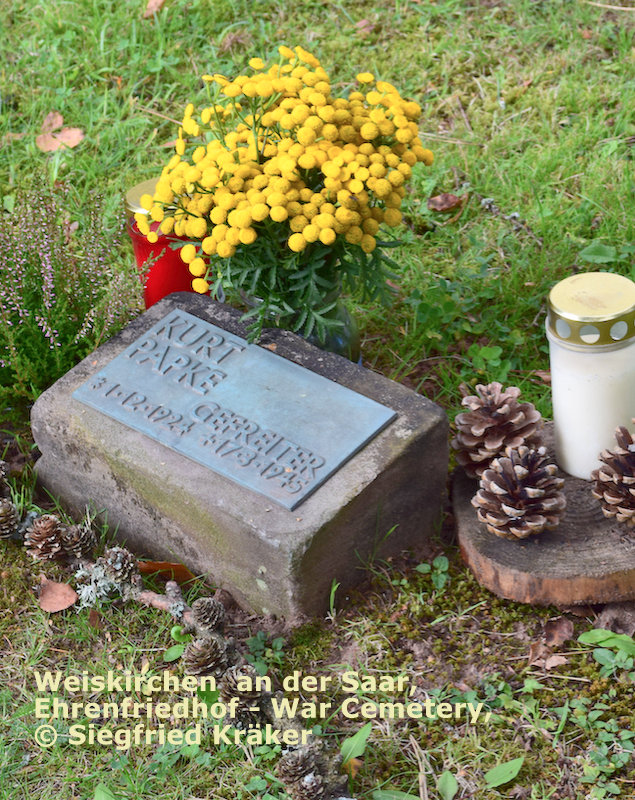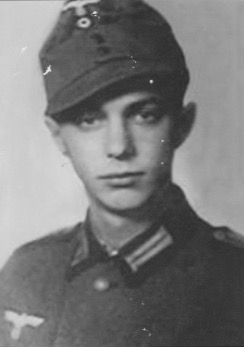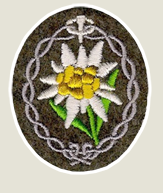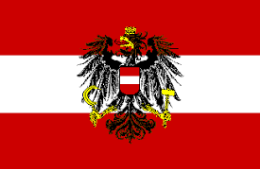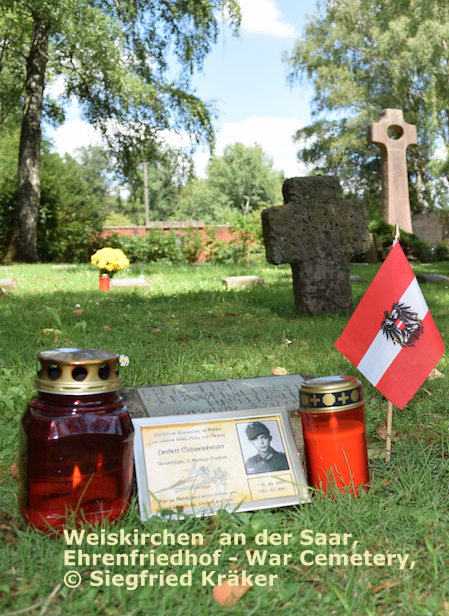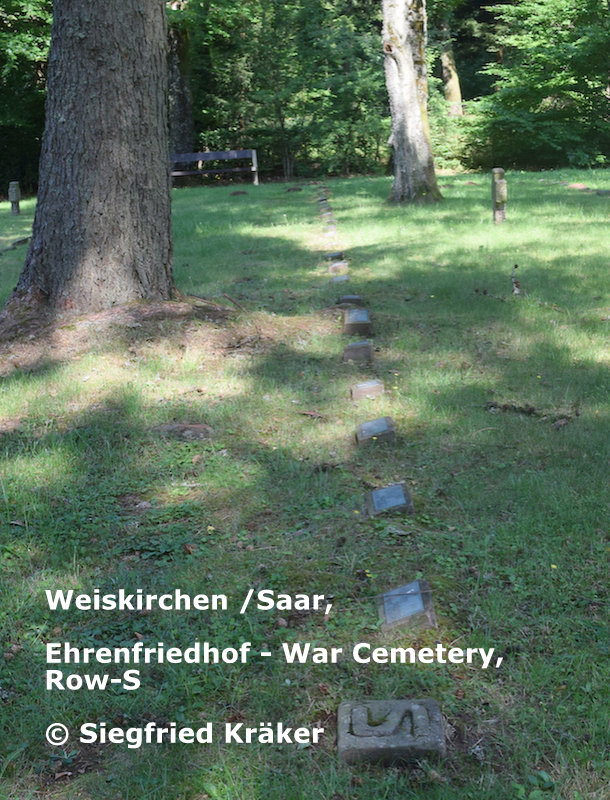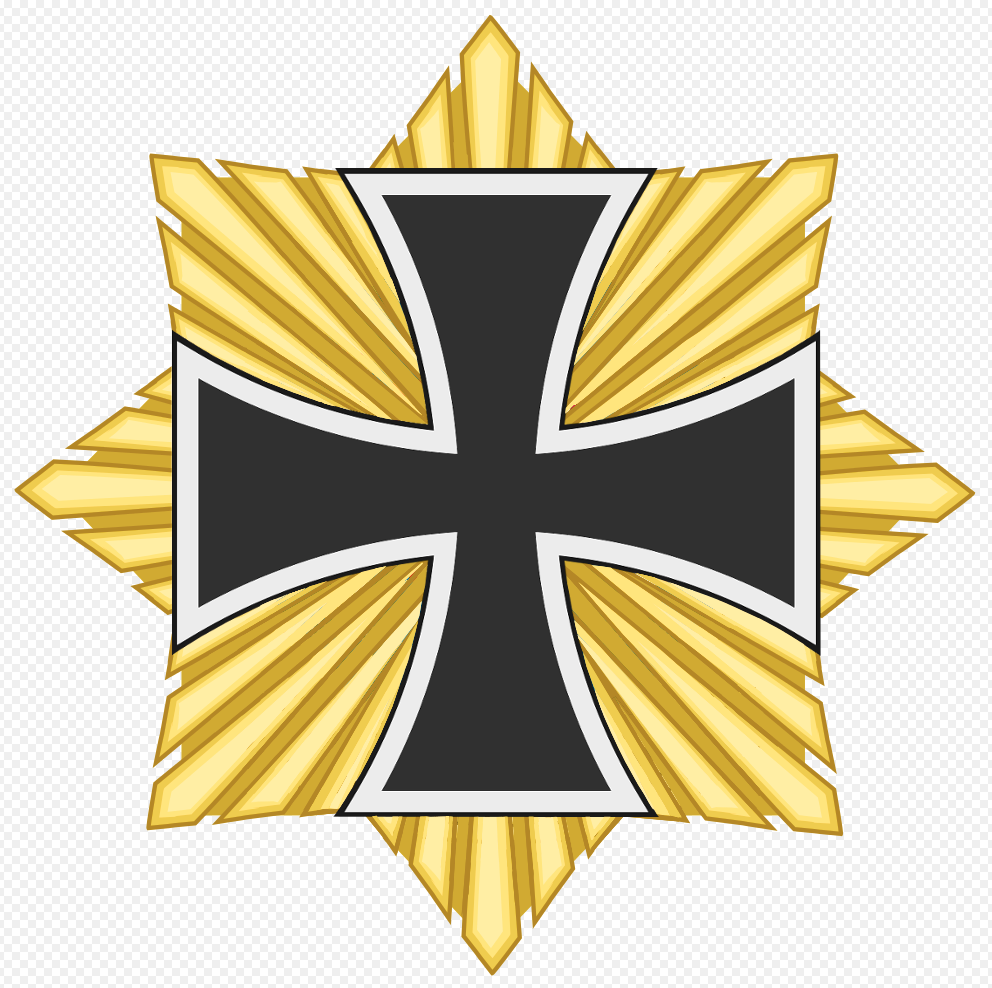
We Remember
Wadern, Merzig-Wadern, Saarland, Germany
We Remember ✅ Everitt Patrick Anthony Clement, Giessen Jakob, Heiligensetzer Wilhelm, Papke Kurt, Schwemberger Herbert killed in action.
Where do they remain?
Wait for me, I'll come back, as many had said, to their wives, mothers, fathers, brothers, sisters and relatives have waited in vain for the homecoming to this day.
Wo sind sie geblieben ?
Wart’ auf mich, ich komm’ zurück, das hatten viele gesagt, zu ihren Frauen, Mütter Väter, Bruder, Schwester und Angehörige warteten vergeblich bis heute auf die Heimkehr.
📌 Name A to Z
📌 Name - E
EVERITT Patrick Anthony Clement
|
ID-Nr: EVERITT Patrick Anthony Clement |
Military Cemetery, Weiskirchen, Wadern, Merzig-Wadern, Saarland, Germany |
| Family Name | EVERITT | Forname(s): | Patrick Anthony Clement |
| Date of Birth: | 25.01.1916 | Gender: | M |
| District of birth: | Norfolk | Country of birth: | United Kingdom |
| Parents-Father: | Sir Clement, Everitt, Sheringham, Norfolk | Parents-Mother: | Lady Everitt, born Croxeter, |
| Married to: | Elise May Everitt | ||
| Resident: | Highmoor, Abbey-road, Sheringham, Norfolk | Country of Origin: | United Kingdom |
| Service at the: | Royal Norfolk Regiment | Field mail number:: | 71104 |
| Regiment:: | 2nd. Bn. Royal Norfolk Regiment | Battalion : | 4th. INF. BDO |
| Platoon: | 2nd Bn. | Squad: | 2nd. Patro |
| Rank: | 2nd. Lieutenant | Field mail number: | P/71104 |
| Prisoner of war: | 2nd. Lieutenant Everitt was severely wounded in action and captured by the German Wehrmacht on the rail embankment between Waldwisse in France and Biringen in Germany | Date of captive : | 07.Jan.1940 |
| Date of Death: | 09.Jan.1940 | Age: | 23 |
| Circumstances leading to Death: | severely wunded during patrol, by German machine-guns | Cause of Death: | loss of blood |
| Place of Death: | Weiskirchen military hospital | District of Death: | Merzig- Wadern |
| Country of Death: | Germany | Federal state of Death: | Saarland |
|
WAR DIARY: 2nd Lieutenant Everitt: |
Excerpt from the War diary - THE ROYAL NORFOLK REGIMENT 4th January 1940 Lt. Everitt was instructed to lead a Patrol into the enemy line during the evening with the mission of identifying enemy positions. The patrol was composed as: 2nd Lieut. P. A. J. Everitt, Pte. J. Jackson, Pte. N. Lilley, and Sgt. V. Newman. Lt. Everitt penetrated into Germany, this was the first time a British Patrol has actually crossed the frontline during the 2ndWW. 5th January 1940 During the morning dawn, Lt. Everitt with his Patrol reported back to the Commander in charge with the statement: mission successfully completed In accordance with the orders he received. In accordance with orders from the 2nd. Bn. Lt. Everitt border patrol unit was relieved from duty by there comrades in arms a relief border Patrol unit. Lt. Everitt with his Patrol traveled back via march route to MONNEREN. At MONNEREN the weather condition had improved and there did not experience such intense cold as it did the way to the front. 6th January 1940 In accordance with the 2nd. Bn. Operatives Orders Lt. Everitt with his Patrol traveled back via march route to KEDANGE which was completed in the afternoon and occupied a forest hutted camp which was built by the 2nd. Bn. |
|
WAR DIARY: 2nd Lieutenant Everitt: |
War Accident Details: An excerpt from the 2nd. Bn War Diary which described the circumstances under which 2nd Lieut. P. A. J. Everitt failed to return from the patrol reads as follows: Sunday, January 7th. 1940, 06:45hrs. a cold winter day with a snow-covered landscape. In accordance with the 2nd. Bn. Operatives Orders Lt. Everitt was sent out by daylight with his Patrol at 06:45 hrs in front of the LOHMUHL WOOD to cover a wiring party. Sunday, January 7th. 1940, 11:00 hrs location: Waldwisse in northern France near the German border village in Biringen. The battalion Carrier Platoon, under Lt. Everitt, led part of his patrol unit to the top of the hill saying he was going to see what he could observe of the enemy and to make a sketch of what he saw. Sunday, January 7th. 1940, 11:30 hrs location: Waldwisse in northern France near the German border village in Biringen. Lt. Everitt led his party over the crest of a hill towards the HELTENBACH to within sight of the enemy and going on alone, attempted with great determination to get near a German defense post. Determined to get ever closer to this enemy defensive position, Lt. Everitt hurried on, opening a considerable gap between himself and his men. Sunday, January 7th. 1940, 12:15 hrs location: rail embankment between Waldwisse in France and Biringen in Germany German machine-guns opened fire, 15 rds of M. G. fire, Suddenly sweeping across the whole area and pinning the patrol to the ground. Lt. Everitt was hit and severely wounded the rest of the patrol pinned to the ground. Eventually, the patrol managed to return over the crest of the hill but without Lt. Everitt. Lt. Everitt, who had gone too far ahead of the patrol, had to be left behind. Lt. Everitt was captured by the German Wehrmacht and taken to the military hospital (Medical Services 179 - Field Hospital 179) in Weiskirchen. Monday, January 8th, 1940, during dawn: Waldwisse in northern France near the German border village in Biringen. A search was conducted to retrieve Lt. Everitt, signs in the snow indicated that he was wounded in a position about 150 to 200 yds from WALDWISSE Sta. but he was nowhere found. Later it was learned from the enemy broadcast station that he is alive but severely wounded and taken in by the Germans. Tuesday, January 9th, 1940, Medical Services 179 - Field Hospital 179 in Weiskirchen Germany. In spite of every medical attention, he died of loss of blood on the 9th of January 1940. 2nd. Lieutenant was buried with full military honors by the 79th Infanterie Division in Weiskirchen War Cemetery. |
| 1st Grave site: |
Weiskirchen an der Saar, Germany, Military Cemetery
|
| Weiskirchen Historical Information: |
The medical services 179 were subordinate to the 79th Infantry Division of the German Wehrmacht. The two medical companies 179 were set up in Bad Ems from August 26 to August 30, 1939. On August 30th the field hospital arrived in Weiskirchen and was ready for the reception on August 31st in the evening. The hospital was able to occupy 200 beds, 50 of which were for the seriously injured. The internal department was set up in the school building, the surgical department in the youth hostel, and a tavern room for segregation cases. A Military Cemetery has been set up near the hospital within a Pinewood forest outside the village of Weiskirchen along the country road L-151 for the deceased soldiers in the hospital and for the fallen soldiers of the 79th ID. All foreign soldiers which deceased during the 2nd.WW at the military hospital in Weiskirchen is first buried in the military cemetery in Weiskirchen. After the war, they were relocated to there respective locations. The remains of Lieutenant Everitt were exhumed after the war and were reburied at the Military Cemetery in Rheinberg. |
| 2nd Grave site: |
RHEINBERG WAR CEMETERY, Germany,
|
| Grave site: | Plot-1, Row-3, Grave-3 |
| Final resting place: |
|
| Web-Link to : |
|
| Grave site, Historical Information: | The site of Rheinberg War Cemetery was chosen in April 1946 by the Army Graves Service for the assembly of Commonwealth graves recovered from numerous German cemeteries in the area. The majority of those now buried in the cemetery were airmen, whose graves were brought in from Düsseldorf, Krefeld, Mönchengladbach, Essen, Aachen, Dortmund, Nunkirchen and Weiskirchen im Saarland; 450 graves were from Cologne (Köln) alone. The men of the other fighting services buried here mostly lost their lives during the battle of the Rhineland, or in the advance from the Rhine (Rhein) to the Elbe. |
| Historical Development & Remarks: |
The medical services 179 were subordinate to the 79th Infantry Division. The two medical companies 179 were set up in Bad Ems from August 26 to August 30, 1939. 29.08.1939, The German Wehrmacht was Occupying the Westwall along the Saar/Mosel river, the main battle line was between Saarbrücken, Saarlouis, Merzig, Saarburg and Trier. 03.09.1939 - 03.11.1939, Defence and protection of the apron in the south/west area of Merzig/Saar was established 05.11.1939 - 09.05.1940, Battlegroups and field fights in the area south/west of Merzig/Saar has started off. 13.05.1940 - 20.05.1940, Attacks has started on Maginot line and on English forest stands of the 2nd Battalion. The Royal Norfolk Regiment. Div. is part of the famous 51st (Highland) Infantry Division which stands oposide of the 79th. Inf. Div. of the German Wehrmacht between Mettlach - Merzig - Beckingen - Dillingen on the river Saar. 17.06.1940 - 24.06.1940, Beginning of the morn on Luneville and advanced to Epinal in France territory. |
| History: |
13.05.1940, beginn of the French campain 25.06.1940. Armistice with France. |
| Research source: | |
| Memorial: | Malvern College WW2 Memorial |
| all rights reserved: | 2015 © by Skr., all rights reserved the Author |
| Return tp Top | To the top |
📌 Name - G
GIESSEN Jakob
|
ID-Nr: GIESSEN Jakob |
Military Cemetery, Weiskirchen, Wadern, Merzig-Wadern, Germany |
| Family Name | GIESSEN | Forname(s): | Jakob |
| Date of Birth: | 26.Oct.1900 | Gender: | M |
| District of birth: | St. Ingbert | Country of birth: | Saarland, Germany |
| Parents-Father: | unknown | Parents-Mother: | unknown |
| Married to: | unknown | ||
| Resident: | St. Ingbert, Saarland | Country of Origin: | Germany |
| Division: | 79th.Infantry Division of the German Wehrmacht | Field mail number:: | 21645 |
| Army corps: | Sep. 1939 to May 1940, XII & XXX | Army group: | 1st. Armee, C, Saarpfalz |
| Unit: | 2.Kp.Ers.Pi.74, Nr77 | Squad: | 2.Kp.Ers.Pi. |
| Rank: | Pionier | Field mail number: | 21645 |
| Prisoner of war: | ....... | Date of captive : | ........ |
| Date of Death: | 09.Sep.1939 | Age: | 38 |
| Circumstances leading to Death: | severely wunded during patrol | Cause of Death: | unknown |
| Place of Death: | Biringen | District of Death: | Merzig- Wadern |
| Country of Death: | Germany | Federal state of Death: | Saarland |
|
79th. Inf. Div. German Wehrmacht: |
30.08.1939, Arrival of the 79th. Inf. Div. in the area of Weiskirchen/Saar. The medical services 179 were subordinate to the 79th Infantry Division of the German Wehrmacht. The two medical companies 179 were set up in Bad Ems from August 26 to August 30, 1939. On August 30th the field hospital arrived in Weiskirchen and was ready for the reception on August 31st in the evening. The hospital was able to occupy 200 beds, 50 of which were for the seriously injured. The internal department was set up in the school building, the surgical department in the youth hostel, and a tavern room for segregation cases. A Military Cemetery has been set up near the hospital within a Pinewood forest outside the village of Weiskirchen along the country road L-151 for the deceased soldiers in the hospital and for the fallen soldiers of the 79th ID. |
| Grave site: |
On 09.09.1939 the first fallen soldiers of this unit Giessen Jakob, Pionier of the Pionier-Bataillon 179, were to be mourned during the apron battles on the Siegfried Line and was buried here at Block-1, Row-3 (C), Grave-22 |
| Weiskirchen at September 1939 : |
The 1st Military Cemetery on the path of the 79th Infantry Division of the German Wehrmacht was established in Sep. 1939 during the 2nd.WW in Weiskirchen
|
| Web-Link to : |
|
|
Grave site Historical Inform.: |
On historical grounds, where there was a Franconian burial place 1,500 years ago. In the grave field, Block 1 and Block 2, there are 19 rows of graves in alphabetical order on the left and right along the main path. The individual gravesites are marked by sandstones with bronze plaques bearing the names of the days of birth and death of the fallen. In another Block-3 there is a comrade's grave, also known as a collective grave, with unknown war victims. On 09.09.1939 the first fallen soldiers of this unit were to be mourned during the apron battles on the Siegfried Line and was buried here. The majority of the members of the 79th Infantry Division fell on French soil in the attack on the Maginot Line on May 13, 1940, near Flatten - a small Lorraine town across the border. In 1939/40 and also in the winter of 1944/45 Weiskirchen was the main first aid station of the Wehrmacht; the last burials within the troops took place around March 15th, 1945. At the beginning of the fifties, the cemetery was expanded by adding additions to graves of war victims from the Bliesgau, Nunkirchen. This war cemetery was laid out in its current form by the Saarland government, in cooperation and with the financial contribution of the Volksbund. The establishment and maintenance of the cemetery are now in the care of the Saarland state government. |
| Historical Development & Remarks: |
The medical services 179 were subordinate to the 79th Infantry Division. The two medical companies 179 were set up in Bad Ems from August 26 to August 30, 1939. 29.08.1939, The German Wehrmacht was Occupying the Westwall along the Saar/Mosel river, the main battle line was between Saarbrücken, Saarlouis, Merzig, Saarburg and Trier. 03.09.1939 - 03.11.1939, Defence and protection of the apron in the south/west area of Merzig/Saar was established 05.11.1939 - 09.05.1940, Battlegroups and field fights in the area south/west of Merzig/Saar has started off. 13.05.1940 - 20.05.1940, Attacks has started on Maginot line and on English forest stands of the 2nd Battalion. The Royal Norfolk Regiment. Div. is part of the famous 51st (Highland) Infantry Division which stands oposide of the 79th. Inf. Div. of the German Wehrmacht between Mettlach - Merzig - Beckingen - Dillingen on the river Saar. 17.06.1940 - 24.06.1940, Beginning of the morn on Luneville and advanced to Epinal in France territory. |
| History: |
13.05.1940, beginn of the French campain 25.06.1940. Armistice with France. |
| Research source: | |
| Memorial: | unknown |
| Web-Link to : |
|
| Web-Link to : |
|
| all rights reserved: | 2015 © by Skr., all rights reserved the Author |
| Return tp Top | To the top |
📌 Name - H
HEILIGENSETZER Wilhelm
|
ID-Nr: HEILIGENSETZER Wilhelm |
Military Cemetery, Weiskirchen, Wadern, Merzig-Wadern, Germany |
| Family Name | HEILIGENSETZER | Forname(s): | Wilhelm |
| Date of Birth: | 20.Jun.1926 | Gender: | M |
| District of birth: | Betzigau | Country of birth: | Oberallgäu in Bavaria, Germany |
| Parents-Father: | unknown | Parents-Mother: | unknown |
| Married to: | unknown | ||
| Resident: | Betzigau, Oberallgäu | Country of Origin: | Germany |
| Division: | 19. Volks Grenadier Division of the German Wehrmacht | Field mail number:: | unknown |
| Army corps: | 9. Oct.1944, LXXIII, | Army group: | 1st. Armee, G, Saarpfalz, |
| Unit: | Grenadier Regiment 74 | Squad: | unknown |
| Rank: | Grenadier | Field mail number: | unknown |
| Prisoner of war: | ....... | Date of captive : | ........ |
| Date of Death: | 13.Mar.1945 | Age: | 18 |
| Circumstances leading to Death: | severely wunded during action | Cause of Death: | unknown |
| Place of Death: | Brebach-Fechingen | District of Death: | Stadtbezirks Saarbrücken Halberg. |
| Country of Death: | Germany | Federal state of Death: | Saarland |
|
79th. Inf. Div. German Wehrmacht: |
30.08.1939, Arrival of the 79th. Inf. Div. in the area of Weiskirchen/Saar. The medical services 179 were subordinate to the 79th Infantry Division of the German Wehrmacht. The two medical companies 179 were set up in Bad Ems from August 26 to August 30, 1939. On August 30th the field hospital arrived in Weiskirchen and was ready for the reception on August 31st in the evening. The hospital was able to occupy 200 beds, 50 of which were for the seriously injured. The internal department was set up in the school building, the surgical department in the youth hostel, and a tavern room for segregation cases. A Military Cemetery has been set up near the hospital within a Pinewood forest outside the village of Weiskirchen along the country road L-151 for the deceased soldiers in the hospital and for the fallen soldiers of the 79th ID. |
| Grave site and final resting place: |
One of the youngest Soldiers 18 years old Heiligensetzer Wilhelm, Grenadier of the 19. Volks Grenadier Division of the German Wehrmacht was buried here at Weiskirchen Plot-1, Row-1 (A), Grave-42 |
| Weiskirchen at September 1939 : |
The 1st Military Cemetery on the path of the 79th Infantry Division of the German Wehrmacht was established in Sep. 1939 during the 2nd.WW in Weiskirchen
|
| Web-Link to : |
|
|
Grave site Historical Inform.: |
On historical grounds, where there was a Franconian burial place 1,500 years ago. In the grave field, Block 1 and Block 2, there are 19 rows of graves in alphabetical order on the left and right along the main path. The individual gravesites are marked by sandstones with bronze plaques bearing the names of the days of birth and death of the fallen. In another Block-3 there is a comrade's grave, also known as a collective grave, with unknown war victims. On 09.09.1939 the first fallen soldiers of this unit were to be mourned during the apron battles on the Siegfried Line and was buried here. The majority of the members of the 79th Infantry Division fell on French soil in the attack on the Maginot Line on May 13, 1940, near Flatten - a small Lorraine town across the border. In 1939/40 and also in the winter of 1944/45 Weiskirchen was the main first aid station of the Wehrmacht; the last burials within the troops took place around March 15th, 1945. At the beginning of the fifties, the cemetery was expanded by adding additions to graves of war victims from the Bliesgau, Nunkirchen. This war cemetery was laid out in its current form by the Saarland government, in cooperation and with the financial contribution of the Volksbund. The establishment and maintenance of the cemetery are now in the care of the Saarland state government. |
| 19. Volks Grenadier Division of the German Wehrmacht: |
Set up on August 8, 1944, in Esbjerg in Denmark and subordinated to the 19th Grenadier Division. The staff came from parts of the Jutland shadow division. On October 9, 1944, it was placed under the 19th People's Grenadier Division and was deployed in the Saar Palatinate at the location to the west of Saarlautern (today Saarlouis) in the area of Bouzonville on France soil. 1.Dec.1944, the 19.VGr was stationary at Merzig an der Saar. On January 13, 1945 the division had a combat strength of 1,500 to 2,000 men. After the loss-making retreat battles were the divisions of the XIII. SS army corps in defense between Saarbrücken and Bitsch. Until the end of January 1945, there was no longer any decisive fighting. Priority was given to the expansion of field positions and the expansion of the western wall. On February 6, 1945, the local attack by US troops began against the right-wing of the already severely weakened 19th People's Grenadier Division. During these attacks, the US troops were able to take possession of the Blieshöhen not far from the city of Saareguemines. 01.Mar.1945, 19.VGr was stationary near Saarbrücken beside 17.SS,Pz.Grn. On March 20, 1945, 19.VGr was moved to Kaiserslautern. |
|
History on the West Wall: |
13.05.1940, beginn of the French campain 25.06.1940. Armistice with France. 06.Feb.1945 US troops began attacking the Saarbrücken area. |
| Research source: | |
| Memorial: | in Betzigau on memorial plaque |
| Web-Link to : |
|
| Web-Link to : |
|
| all rights reserved: | 2015 © by Skr., all rights reserved the Author |
| Return tp Top | To the top |
📌 Name - P
PAPKE Kurt
|
ID-Nr: PAPKE Kurt |
Military Cemetery, Weiskirchen, Wadern, Merzig-Wadern, Germany |
| Family Name | PAPKE | Forname(s): | Kurt |
| Date of Birth: | 01.Dec.1924 | Gender: | M |
| Place of birth: | Simötzel, Ost Preußen | Country of birth: | Ost Preußen, Germany |
| Parents-Father: | unknown | Parents-Mother: | unknown |
| Married to: | unknown | ||
| Resident: | Simötzel, Kreis Kolberg-Körlin in Pommern | Country of Origin: | Ost Preußen, Germany |
| Division: | 17. SS-Panzergrenadier-Division "Götz von Berlichingen" | Field mail number:: | unknown |
| Army corps: | Feb 1945 to March 1945 XIII SS, | Army group: | 1st. Armee, G, Saarpfalz, |
| Unit: | 17. SS Pz. Gren. Div. | Squad: | unknown |
| Rank: | Corporal (Obergefreiter) | Field mail number: | unknown |
| Prisoner of war: | ....... | Date of captive : | ........ |
| Date of Death: | 17.Mar.1945 | Age: | 19 |
| Circumstances leading to Death: | mortally wounded during action | Cause of Death: | unknown |
| Place of Death: | Triebenberg, Westwallbunker at Saarbrücken- Ensheim | District of Death: | Stadtbezirks Saarbrücken Halberg. |
| Country of Death: | Germany | Federal state of Death: | Saarland |
|
79th. Inf. Div. German Wehrmacht: |
30.08.1939, Arrival of the 79th. Inf. Div. in the area of Weiskirchen/Saar. The medical services 179 were subordinate to the 79th Infantry Division of the German Wehrmacht. The two medical companies 179 were set up in Bad Ems from August 26 to August 30, 1939. On August 30th the field hospital arrived in Weiskirchen and was ready for the reception on August 31st in the evening. The hospital was able to occupy 200 beds, 50 of which were for the seriously injured. The internal department was set up in the school building, the surgical department in the youth hostel, and a tavern room for segregation cases. A Military Cemetery has been set up near the hospital within a Pinewood forest outside the village of Weiskirchen along the country road L-151 for the deceased soldiers in the hospital and for the fallen soldiers of the 79th ID. |
| 1st Grave site: |
Triebenberg an der Saar, Germany, Military Cemetery
|
| 2nd Grave site and final resting place: |
One of the youngest Soldiers 19 years old PAPKE Kurt, Corporal (Obergefreiter) of the 17. SS-Panzergrenadier-Division "Götz von Berlichingen" was buried here at Weiskirchen Plot-1, Row-9 (J), Grave-18 |
| Weiskirchen at September 1939 : |
The 1st Military Cemetery on the path of the 79th Infantry Division of the German Wehrmacht was established in Sep. 1939 during the 2nd.WW in Weiskirchen
|
| Web-Link to : |
|
|
Weiskirchen Grave site Historical Information: |
On historical grounds, where there was a Franconian burial place 1,500 years ago. In the grave field, Block 1 and Block 2, there are 19 rows of graves in alphabetical order on the left and right along the main path. The individual gravesites are marked by sandstones with bronze plaques bearing the names of the days of birth and death of the fallen. In another Block-3 there is a comrade's grave, also known as a collective grave, with unknown war victims. On 09.09.1939 the first fallen soldiers of this unit were to be mourned during the apron battles on the Siegfried Line and was buried here. The majority of the members of the 79th Infantry Division fell on French soil in the attack on the Maginot Line on May 13, 1940, near Flatten - a small Lorraine town across the border. In 1939/40 and also in the winter of 1944/45 Weiskirchen was the main first aid station of the Wehrmacht; the last burials within the troops took place around March 15th, 1945. At the beginning of the fifties, the cemetery was expanded by adding additions to graves of war victims from the Bliesgau, Nunkirchen. This war cemetery was laid out in its current form by the Saarland government, in cooperation and with the financial contribution of the Volksbund. The establishment and maintenance of the cemetery are now in the care of the Saarland state government. |
| 17th SS Panzer Grenadier Division of the German Wehrmacht: |
On September 2, 1944, the 17.SS Pz.Gr. Div. was placed under the XIII. SS-Armeekorps and was deployed in the Saar Palatinate at the location to the west of Saarlautern (today Saarlouis) in the area of Metz on France soil to took over a section of the front south of Metz at the XIII. SS Army Corps. On October 1 1944 , the 17.SS Pz.Gr. Div. to took over a section of the front south of Metz at the XIII. On November 1, 1944, the 17.SS Pz.Gr. Div. at the location to the west of Saargemünd in the south of Metz on France soil. On November 8th, the Americans broke the division's bridgehead, 1.Dec.1944, the 17th SS Panzer Grenadier Division was stationary at Saargemünd. 23.Jan.1945, the 17th SS Panzer Grenadier Division was stationary near Saarbrücken. 6.Feb.1945, the local attack by US troops began against the right-wing of the already severely weakened 17th SS Panzer Grenadier Division (Götz von Berlichingen). During these attacks, the US troops were able to take possession of the Blieshöhen not far from the city of Saargemünd. 01.Mar.1945, the 17.SS,Pz.Grn. was stationary near Saarbrücken beside 19.VGr. 15.Mar.1945, Aircraft of the 12th US Tactical Air Command flew ground support missions to bomb the Siegfried Line positions on the Triebenberg near Bischmisheim. 15.Mar.1945, attack of the 254th Infantry Regiment, 63rd US Division on Ensheim. 20.Mar.1945, the German Wehrmacht units of the 17th SS Panzer Grenadier Division (Götz von Berlichingen) gave up the position on the Westwall Bunker in Triebenberg and retreated towards the Rhine. |
|
History on the West Wall: |
13.05.1940, beginn of the French campain 25.06.1940, Armistice with France. 06.Feb.1945, US troops began attacking the Saarbrücken area. 20.Mar.1945, 17th SS Panzer Grenadier Division gave up the position on the Westwall Bunker in Triezenberg and retreated towards the Rhine. |
| Research source: | |
| Memorial: |
|
| Web-Link to : |
|
| Web-Link to : |
|
| all rights reserved: | 2015 © by Skr., all rights reserved the Author |
| Return tp Top | To the top |
📌 Name - S
SCHWEMBERGER Herbert
|
ID-Nr: SCHWEMBERGER Herbert |
Military Cemetery, Weiskirchen, Wadern, Merzig-Wadern, Germany |
| Family Name | SCHWEMBERGER | Forname(s): | Herbert |
| Date of Birth: | 21.Oct.1919 | Gender: | M |
| Place of birth: | Kufstein, Tirol | Country of birth: | Austria |
| Parents-Father: | unknown | Parents-Mother: | unknown |
| Married to: | unknown | ||
| Resident: | Kufstein, Tirol | Country of Origin: | Austria |
| Division: | 2. Gebirgs-Division" | Field mail number:: | unknown |
| Army corps: | March. 1945 LXXXII, | Army group: | 1st. Armee, G, Hunsrück, |
| Unit: | Mountaineer of 2nd Mountain Division | Squad: | unknown |
| Rank: | Sergeant (Unteroffizier) | Field mail number: | unknown |
| Prisoner of war: | ....... | Date of captive : | ........ |
| Date of Death: | 03.Mar.1945 | Age: | 25 |
| Circumstances leading to Death: | mortally wounded during action | Cause of Death: | unknown |
| Place of Death: | near Lampaden at the area Hunsrück | District of Death: | Trier-Saarburg |
| Country of Death: | Germany | Federal state of Death: | Rhineland- Palatinate |
|
79th. Inf. Div. German Wehrmacht: |
30.08.1939, Arrival of the 79th. Inf. Div. in the area of Weiskirchen/Saar. The medical services 179 were subordinate to the 79th Infantry Division of the German Wehrmacht. The two medical companies 179 were set up in Bad Ems from August 26 to August 30, 1939. On August 30th the field hospital arrived in Weiskirchen and was ready for the reception on August 31st in the evening. The hospital was able to occupy 200 beds, 50 of which were for the seriously injured. The internal department was set up in the school building, the surgical department in the youth hostel, and a tavern room for segregation cases. A Military Cemetery has been set up near the hospital within a Pinewood forest outside the village of Weiskirchen along the country road L-151 for the deceased soldiers in the hospital and for the fallen soldiers of the 79th ID. |
| 1st Grave site and final resting place: |
One of the Austrien Soldiers SCHWEMBERGER Herbert, Sergeant (Unteroffizier) of the 2. Gebirgs-Division or (“Mountain Hunter”) was buried here at Weiskirchen Block-2, Row-5 (S), Grave-24 |
| Weiskirchen at September 1939 : |
The 1st Military Cemetery on the path of the 79th Infantry Division of the German Wehrmacht was established in Sep. 1939 during the 2nd.WW in Weiskirchen
|
| Web-Link to : |
|
|
Weiskirchen Grave site Historical Information: |
On historical grounds, where there was a Franconian burial place 1,500 years ago. In the grave field, Block 1 and Block 2, there are 19 rows of graves in alphabetical order on the left and right along the main path. The individual gravesites are marked by sandstones with bronze plaques bearing the names of the days of birth and death of the fallen. In another Block-3 there is a comrade's grave, also known as a collective grave, with unknown war victims. On 09.09.1939 the first fallen soldiers of this unit were to be mourned during the apron battles on the Siegfried Line and was buried here. The majority of the members of the 79th Infantry Division fell on French soil in the attack on the Maginot Line on May 13, 1940, near Flatten - a small Lorraine town across the border. In 1939/40 and also in the winter of 1944/45 Weiskirchen was the main first aid station of the Wehrmacht; the last burials within the troops took place around March 15th, 1945. At the beginning of the fifties, the cemetery was expanded by adding additions to graves of war victims from the Bliesgau, Nunkirchen. This war cemetery was laid out in its current form by the Saarland government, in cooperation and with the financial contribution of the Volksbund. The establishment and maintenance of the cemetery are now in the care of the Saarland state government. |
| 2. Gebirgs-Division or (“Mountain Hunter”) : |
Die 2. Gebirgs-Division wurde am 1. April 1938 in Innsbruck, im Wehrkreis XVIII, aufgestellt. Prior to annexation by Nazi Germany, and even prior to the existence of the Third Reich, Austrian mountain troops and ski troops had made a name for themselves, not just as soldiers, but also as superior mountaineers and downhill/cross-country skiers. Gebirgsjäger (“Mountain Hunter”) units were created in 1906 as a force to defend the region of the South Tyrol, part of the border of what was the old Austro-Hungarian empire, and now the border between Austria and Italy. Later units were formed in order to operate in the Carpathian Mountains by the Hungarian “side” of the empire. Existing Landesschützen (“State Rifles”) and Genderme (Border Police) units were converted for the purpose. These units gained an excellent reputation during WW1 for their fighting abilities and proficiency for operating in mountainous climates. The Austro-Hungarian Gebirgsjäger adopted the Edelweiss as their distinctive unit insignia. The Edelweiss symbolized martial prowess, bravery, rugged beauty and purity to many people living in the Alps region for centuries (ancient examples being found on Roman gravestones for Austrian Soldiers): In February 1945, the 2nd Mountain Division was deployed in the Saarpfalz, upper Alsace region, and the Hunsrück the region south of Trier. 23.Feb.1945, the 94th Infantry Division (United States) under the command of Lieutenant Colonel William A. McNulty, of the 94th's 3rd Battalion, 301st Infantry Regiment crossed the icy and swollen Saar at Serrig. 2 March 1945, by this time the 94th Infantry Division (United States) stretched over a 10-mile front, from Hocker Hill on the Saar through Zerf, and Lampaden to Ollmuth at the area Husnsrück. 02.03.1945, At that time the 2nd. Mountain Division was operating in the area Hunsrück between Trier on the Mosel and was stationary in Weiskirchen in Saarland. 03.03.1945, At that time the 2nd. Mountain Division of the German Wehrmacht was operating against the 94th Infantry Division (United States) near Lampaden. A heavy German attack near Lampaden achieved penetrations, but the line was shortly restored by the 94th Infantry Division (United States) and with heavy losses to the German Army . |
|
History on the West Wall: |
13.05.1940, beginn of the French campain 25.06.1940, Armistice with France. 06.Feb.1945, US troops began attacking the Saarbrücken area. 23.Feb.1945, the 94th Infantry Division (United States) crossed the river Saar at Serrig. 02.Mar.1945, the frontline of the 94th Infantry Division (United States) stretched over a 10-mile front, from Hocker Hill on the Saar through Zerf, and Lampaden to Ollmuth. 03.03.1945, At that time the 2nd. Mountain Division of the German Wehrmacht was operating against the 94th Infantry Division (United States) near Lampaden. 20.Mar.1945, 17th SS Panzer Grenadier Division gave up the position on the Westwall Bunker in Triezenberg and retreated towards the Rhine. |
| Research source: | |
| Memorial: |
|
| Web-Link to : |
|
| Web-Link to : |
|
| Web-Link to : |
|
| all rights reserved: | 2015 © by Skr., all rights reserved the Author |
| Return tp Top | To the top |




